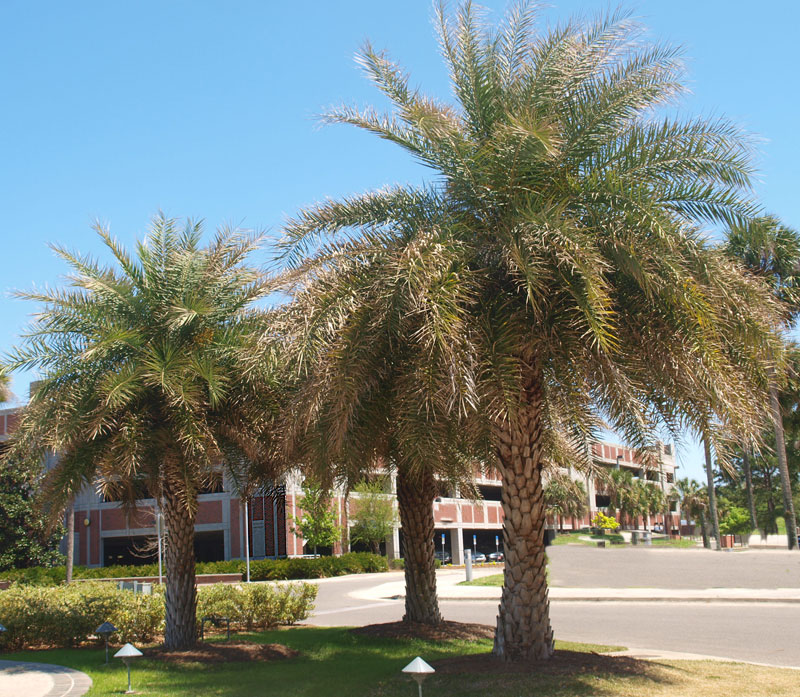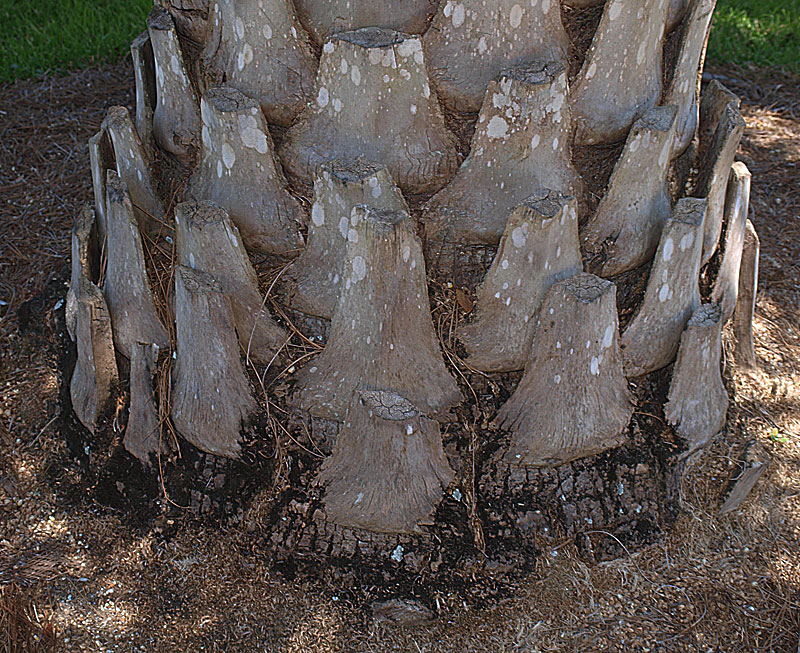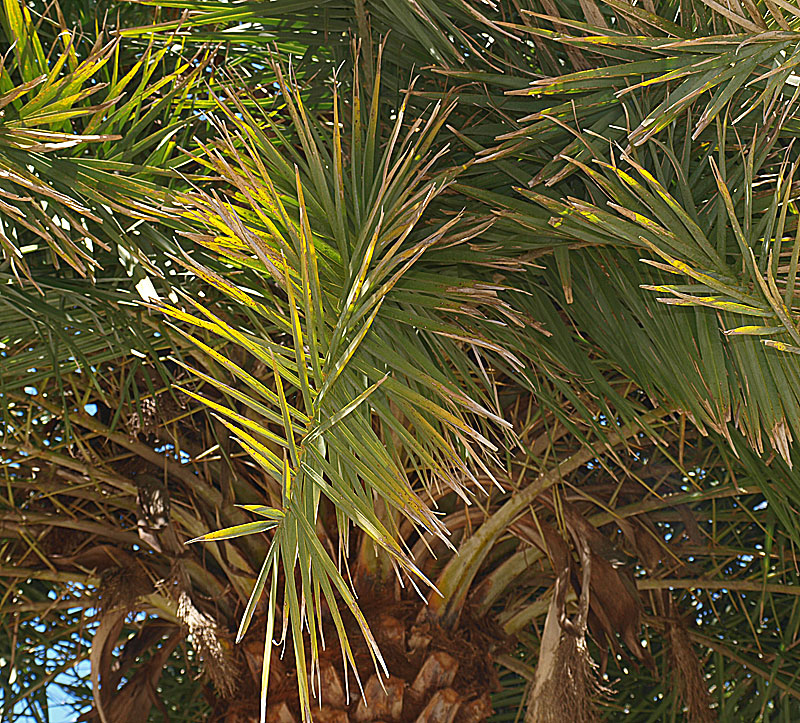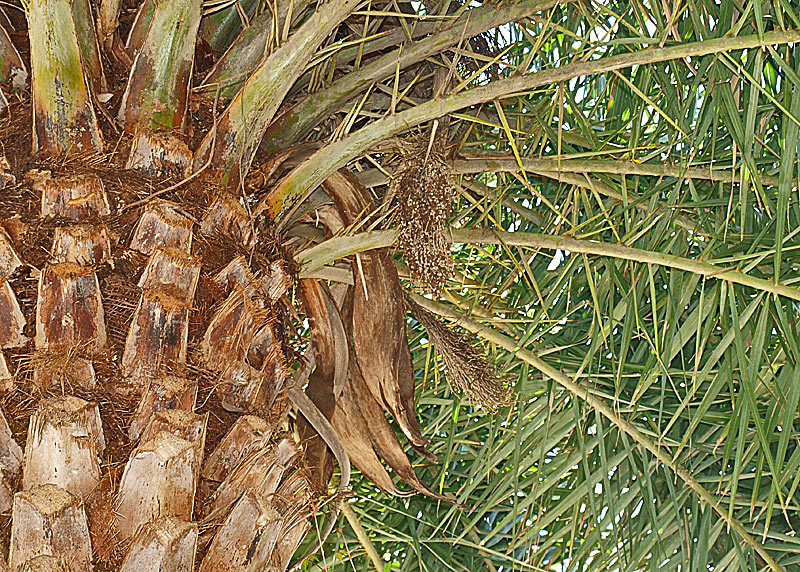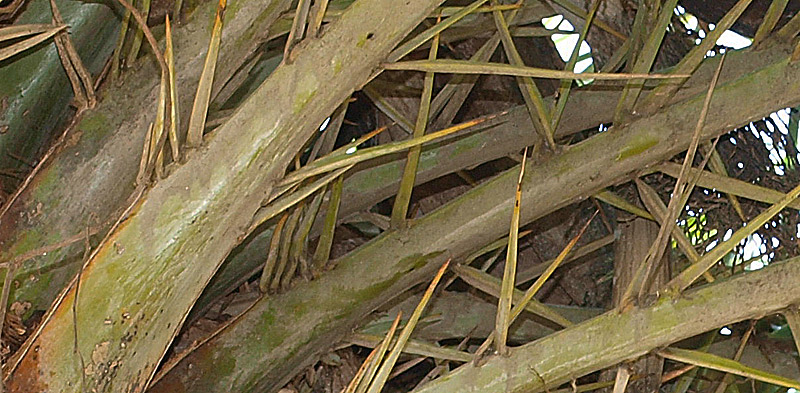Phoenix sylvestris
|
Phoenix sylvestris habit |
|
Phoenix sylvestris base of stem |
|
Phoenix sylvestris leaf |
|
Phoenix sylvestris base of canopy |
|
Phoenix sylvestris leaf spines |
Common name
silver date palm, India date palm, wild date palm
Description
Stems: Solitary, not as large as P. canariensis, but very robust, erect to 15 m tall and 45 cm in diameter, bulging with above ground roots at the base and sometimes bulging at the top of the stem with old leafleaf:
in palms -- the leaf blade (which is usually divided into leaflets or leaf segments), the petiole (or leaf stalk) and the sheath (which forms the attachment of the leaf to the stem)
bases and fibers; leafleaf:
in palms -- the leaf blade (which is usually divided into leaflets or leaf segments), the petiole (or leaf stalk) and the sheath (which forms the attachment of the leaf to the stem)
scars are prominent, raised, and broadly diamond-shaped. Leaves: Pinnatepinnate:
like a feather; palms with pinnate leaves usually have compound leaflets attached to a rachis, although a pinnate leaf may be entire with pinnate veins (e.g., <em>Chamaedorea metallica</em>)
, induplicateinduplicate:
Most palm leaflets or leaf segments are obviously folded. If the folds create a V-shape, with the midrib lower than the margins (so that rain might fall "into a valley"), the folding is induplicate.
, to 4-5 m long, with a gently arching rachisrachis:
an extension of the petiole through the blade of a pinnate leaf to which leaflets are attached
which ends in a single leaflet; many narrow, blue-green leaflets, arranged in several planes, and grouped in twos and threes; the lowermost leaflets (along the short petiole) are modified into sharp, thin spines; and no crown shaftcrown shaft:
a cylinder of clasping leaf sheaths toward the apex of the stem, found in some pinnate-leaved palms (e.g., <em>Wodyetia bifurcata</em>)
is formed from leafleaf:
in palms -- the leaf blade (which is usually divided into leaflets or leaf segments), the petiole (or leaf stalk) and the sheath (which forms the attachment of the leaf to the stem)
sheaths. Flowers and fruit: Inflorescences are yellowish, to 1 m long, and branched to one order. Staminatestaminate:
a flower bearing stamens but no pistils; a “male” flower
and pistillatepistillate:
a flower bearing a pistil but no stamens; a “female” flower
flowers are produced on different plants and are white in color. Fruits are up to 2.5 cm long, ovoid and orange-yellow ripening to red-purple.
Diagnostic features
Field: Solitary palm, not as large as P. canariensis, but very robust, bulging with above ground roots at the base and sometimes bulging at the top of the stem with old leafleaf:
in palms -- the leaf blade (which is usually divided into leaflets or leaf segments), the petiole (or leaf stalk) and the sheath (which forms the attachment of the leaf to the stem)
bases and fibers; leafleaf:
in palms -- the leaf blade (which is usually divided into leaflets or leaf segments), the petiole (or leaf stalk) and the sheath (which forms the attachment of the leaf to the stem)
scars are prominent, raised, and broadly diamond-shaped. Pinnatepinnate:
like a feather; palms with pinnate leaves usually have compound leaflets attached to a rachis, although a pinnate leaf may be entire with pinnate veins (e.g., <em>Chamaedorea metallica</em>)
, induplicateinduplicate:
Most palm leaflets or leaf segments are obviously folded. If the folds create a V-shape, with the midrib lower than the margins (so that rain might fall "into a valley"), the folding is induplicate.
leaves, to 4-5 m long, with a gently arching rachisrachis:
an extension of the petiole through the blade of a pinnate leaf to which leaflets are attached
which ends in a single leaflet; many narrow, blue-green leaflets, arranged in several planes, and grouped in twos and threes.
May be confused with
Other Phoenix species, but the stem and leaflet arrangement are distinctive
Distribution
Native to India and Pakistan
Additional comments
Because Phoenix species can hybridize easily and produce fertile crosses, determining the species within this genus might not be possible.
Scientific name
Phoenix sylvestris (L.) Roxb.
Family
Arecaceae/Palmae
Synonyms
Elate sylvestris L.


